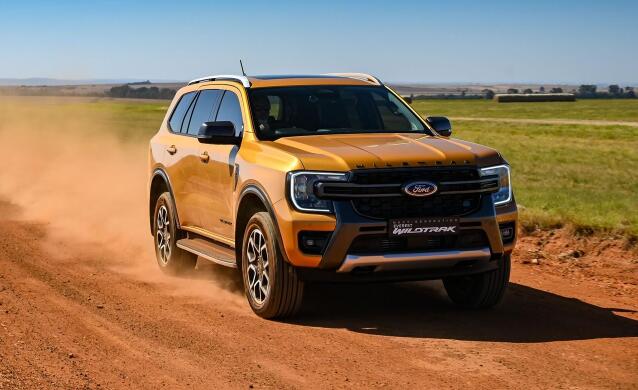Ford recently expanded the Everest line-up with new Wildtrak and XLT variants. We took them to the Pilanesberg Game Reserve.
ON THE back of the recently launched Ford Everest Sport and Platinum models, the Pretoria-based manufacturer has added two more variations to the mix with the XLT and Wildtrak.
Technically there are three new derivatives with the Wildtrak 4×4, the XLT in 4×4 and 4×2 guise and the Sport is now also available with a 4×2 transmission.
To add to the Everest’s street credibility, it recently won the SA Guild of Mobility Journalists’ Adventure SUV category.
The Wildtrak sits just below the range-topping Platinum while the two XLTs are the introduction models to the Everest.
We’ve been asking whether the Ford Everest would ever be launched in a Raptor guise and the answer has been a firm no, so the closest it’s likely to be is the Wildtrak with its more rugged looks.
Under the bonnet sits the same V6 turbo diesel engine found in the Platinum that’s good for 184kW and 600Nm and is paired to Ford’s 10-speed automatic transmission.
In the XLT there’s the tried and trusted 2.0-litre bi-turbo diesel mill with 154kW and 500Nm connected to the same 10-speed gearbox.
Apart from the Luxe Yellow that’s exclusive to the Wildtrak, the exterior is set apart by “WILDTRAK” lettering on the bonnet, a bolder grey grille and silver bash plate.
Standard it stands on two-tone 20-inch alloys but if you prefer to spend more time off-road, there’s the option of 18-inch wheels with all terrain tyres.
If you’re familiar with the Ranger Wildtrak, the interior is pretty much the same with yellow stitching on the dashboard, door trims and steering wheel as well as seats with embossed Wildtrak lettering.
There’s a dual-panel Moon Roof, eight-way adjustable driver’s seat, USB-A and USB-C ports, wireless charging pad and a quality audio system with eight speakers that properly rocks the interior.
Ford’s 12-inch touchscreen infotainment system, with SYNC 4A with a dedicated offroad screen, dominates the centre of the dash and the driver gets an eight-inch digital instrument cluster that can be configured to your liking.
For lifestyle enthusiasts there’s a handy 400W/240V inverter to run accessories such as a fridge or charging electronic gadgets.
While the XLT may be the entry to the range, it doesn’t mean it’s sparse in its offering.
Standing on 18-inch alloys it’s set apart by chrome horizontal grille bars and colour-coded treatment for door handles and mirrors. It also has the same LED lighting treatment as the higher specced models.
There’s no tyre pressure monitoring or adaptive cruise control, which certainly isn’t a deal breaker, but you do get the same adjustable driver’s seat, infotainment and instrument cluster, wireless charging pad and USB ports.
Both have the same interior space with 259 litres of luggage space behind the third row of seats, but with them folded down there’s 898 litres and when they’re all flat an impressive 1,823 litres.
Having driven the Everest Sport over 3 000 kilometres during December, the new XLT’s characteristics are not dissimilar.
The 2.0-litre twin-turbo diesel motor provides decent acceleration while the software upgrades to the gearbox are a big improvement over the previous generation, providing effortless changes throughout the 10 gears.
The driving position and seating fits almost perfectly and while it may not be equipped with all the nice to haves, you certainly don’t notice it with regular driving.
Cruising at the national speed limit on the highway it feels well planted and you wonder why there’s an option for the V6.
That’s until you slide in behind the wheel of the Wildtrak.
The interior shouts premium quality everywhere you look or touch and pressing the start/stop button kicks a sublime engine into life.
It purrs silently as you accelerate and again, it and the gearbox are paired so well that you hardly notice the cogs switching.
With that 600Nm of torque, passing slower traffic is done effortlessly and on occasion it didn’t need to change down before surging forward with very little wind or road noise.
A short drive through the Pilanesberg Game Reserve allowed us to experience its gravel road manners and it proved comfortable albeit a tad hard, but I suspect that was probably due to harder tyre pressures.
We didn’t need any of its 4×4 prowess but when it gets rough there’s an on-demand electromechanical two-speed transfer case with 2H, 4A (automatic, which sends power where needed depending on conditions), 4H and 4L. Modes such as Normal, Eco, Tow/Haul, Slippery, Mud & Ruts and Sand further enhance its abilities.
As with the XLT, the Wildtrak made short work of the stuffed North West roads destroyed by lack of maintenance (what else?) and heavily loaded mining trucks.
Initially we were under the impression that only the Sport and Platinum Everest would be available but Ford has clearly seen the value in adding to the range and that can only be a good thing for prospective owners and sales.
It comes with a four-year/120,000km warranty, four-year/unlimited distance Roadside Assistance and five-year/unlimited distance corrosion warranty.
Customers have the option of purchasing service or maintenance plans up to eight years or 165,000km. The warranty can be extended up to seven years or 200,000km, while the Roadside Assistance can be extended for an additional one or two years.
Pricing (June 2022)
Everest XLT 2.0L BiT 4×2 10AT – R832,400
Everest XLT 2.0L BiT 4×4 10AT – R896,300
Everest Sport 2.0L BiT 4×2 10AT – R918,500
Everest Sport 2.0L BiT 4×4 10AT – R984,800
Everest Wildtrak 3.0L V6 4WD 10AT – R1,084,000
Everest Platinum 3.0L V6 4WD 10AT – R1,146,500
IOL Motoring








